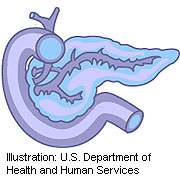
TUESDAY, Jan. 17 (HealthDay News) — A new blood test may hold promise as a means of early detection and diagnosis for often deadly pancreatic cancers.
Reporting Tuesday at the annual Gastrointestinal Cancers Symposium in San Francisco, researchers said the test, which measures levels of a protein known as PAM4, was able to identify two-thirds of patients who had pancreatic cancer at an early stage of their disease.
Early pancreatic tumors typically fly under the radar, causing no symptoms and going undetected until they have spread. This partially accounts for the dismal prognosis faced by most people diagnosed with the illness.
That’s why any means of spotting these cancers early would be critical. According to the researchers, PAM4 is a protein that is present in normal cells but is greatly elevated in cancerous ones.
“When a person gets cancer, this protein spills into the bloodstream,” explained Dr. Igor Astsaturov, an assistant professor of medical oncology at Fox Chase Cancer Center in Philadelphia. Astsaturov, who was not involved with the study, said the results were “certainly welcome news.”
When the researchers combined PAM4 with another test, CA19-9, which is already approved to monitor pancreatic cancer during treatment, the combination showed even stronger results and correctly identified 85 percent of patients with pancreatic ductal adenomcarcinoma (PDAC), by far the most common form of pancreatic cancer.
More study of PAM4 may even point to possible targets for therapy, the authors stated.
“For providers of care for patients with pancreatic cancer, hampered by their inability to readily detect these cancers in some cases, especially in earlier stages, this shows tremendous promise that blood-based assay can add to our ability to diagnose pancreatic cancer at an earlier stage, thereby impacting patients lives,” said Dr. Morton S. Kahlenberg, a gastrointestinal cancers expert with the American Society of Clinical Oncology and moderator of a Tuesday press briefing on the findings.
In previous research by the same group of authors, the PAM4 test was able to identify 82 percent of patients with PDAC. That study included about 80 participants, said study author David V. Gold, director of laboratory administration and a senior member with Garden State Cancer Center in Morris Plains, N.J.
The current study updates those results by including blood samples from almost 300 people previously diagnosed with PDAC, 99 with other types of cancer, 126 with benign pancreatic disease and 79 healthy controls.
Meanwhile, the test had relatively few false positives, mistakenly identifying only 19 percent of benign pancreatic disease patients and 23 percent of chronic pancreatitis patients.
The tests did not appear to be helpful in finding other forms of pancreatic cancer, the researchers stressed.
A second abstract being presented at the symposium also demonstrated the potential utility of these types of diagnostic “biomarkers,” this time in identifying which people with Barrett’s esophagus are more likely to develop esophageal cancer.
Barrett’s esophagus involves changes to the esophageal lining, which sometimes continues into cancer. People with long-term gastroesophageal reflux disease (GERD) are at particular risk.
Right now, doctors use endoscopy and standard biopsies along the length of the esophagus to monitor for cancer However, this isn’t able to sort out tiny changes that separate those at very high risk for cancer from those at much lesser risk.
In this study, “optical biomarkers,” which combine a special microscope with a broad-band white-light source, was able to sort out three characteristics of the cell nucleus that signaled a person was at risk for cancer.
In 60 patients with Barrett’s esophagus, the biomarkers were able to correctly identify 89 cases of cancer and 76 percent of those without cancer.
If these biomarkers were affirmed in future studies, it would preclude the need for repeated biopsies in people with Barrett’s, the authors said.
Data presented at medical meetings is typically considered preliminary until published in peer-reviewed medical journals.
More information
Find out more about pancreatic cancer at the U.S. National Cancer Institute.

